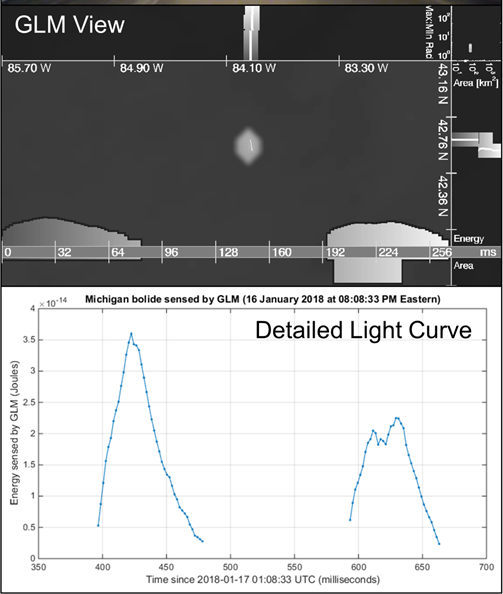UPDATE: Geostationary Lightning and Meteor Mapper?
August 27, 2018 05:23 AM
A fireball was widely observed slightly south of Howell, Michigan (near Detroit) on January 16, 2018 at 8:08:33 PM Eastern. This bolide, like many others, was observed by the Geostationary Lightning Imager (GLM) instrument on the GOES-East weather satellite. Along with lightning, the GLM observes fireballs with equal sensitivity everywhere within its coverage area. The GLM images the Earth 500 times every second and is able to measure the shape of the meteor “light curve”, or how bright it was versus time, with millisecond precision. The largest fireball observed by the GLM so far occurred over the Atlantic Ocean on March 11th, 2017 and was reported by other U.S. Government sensors to be equivalent to an explosion of 2.9 kilotons of TNT. The GLM fireball light curve observations help study meteor threats to the Earth. CICS-MD Scientists Scott Rudlosky and Michael Peterson retrieved the GLM data, shown below.

UPDATE: Rudlosky is now the coauthor of a new article in press at Meteoritics and Planetary Science and published online on July 15 on this event and nine others. The objects detected by GLM are “bolides,” large meteors that explode in the atmosphere. According to the article, only 13 radiometric light curves for bolides were published from 1988 to 2008. The new GLM produced light curves for 10 bolides in less than one year during post-launch test maneuvers. The GLM data allowed meteoriticists to determine flight paths for some of bolides and to recover meteorites for one. They conclude that the GLM will indeed make a good “Global Meteor Mapper.” Jenniskens, Peter, Jim Albers, Clemens E. Tillier, Samantha F. Edgington, Randolph S. Longenbaugh, Steven J. Goodman, Scott D. Rudlosky, Alan R. Hildebrand, Lincoln Hanton, Fabio Ciceri, Richard Nowell, Esko Lyytinen, Donald Hladiuk, Dwayne Free, Nicholas Moskovitz, Len Bright, Christopher O. Johnston and Eric Stern, 2018: Detection of meteoroid impacts by the Geostationary Lightning Mapper on the GOES‐16 satellite, Meteorit. Planet. Sci., https://doi.org/10.1111/maps.13137, in press.
« Back